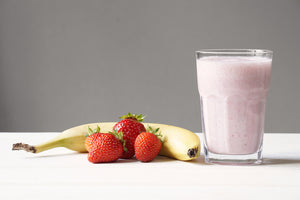We ditched low-fat diets years ago and now many people agree that a lower-carb diet is the way to go.
But what about protein? Numerous studies have found high protein diets to benefit weight loss and metabolic health [1, 2].
Protein is an essential macronutrient that helps with satiety. When we eat higher protein meals, we are less likely to overeat at that meal or later in the day.
But a high-protein diet can be challenging for some. Below are some tips to help you increase your protein intake for better health.
1. Familiarize Yourself with Food Labels

If you aren’t already, familiarize yourself with the food label provided on packaged food items.
This label will tell you the amount of protein in the product and allow you to make some adjustments to the brands and products you purchase. This is an easy and simple way to boost your protein without making too many drastic changes in your eating habits.
For example, if you are someone who typically prefers breakfast cereal in the morning, compare different brands.
If you normally choose Honey Nut Cheerios, you will see one serving provides 2 grams of protein and 9 grams of sugar. You can swap out this cereal for a higher protein and lower sugar option, such as Kashi GO Rise, which includes 11 grams of protein and only 1 gram of sugar.
You are still getting your cereal for breakfast but now you are getting in an extra 9 grams of protein and cutting your sugar down by 8 grams in just one meal.
2. Make Healthy Swaps

This one is simple. Consider some protein sources you enjoy with the list below as an example of good protein sources.
Look at your everyday meals and snacks. If you don’t have a protein source add one or swap out your meal or snack entirely for a higher protein option. When we make our meals, it’s easy to forget the protein sometimes.
For example, if you are having pasta or a salad, sometimes the protein gets left out and we don’t know why we are feeling hungry again so soon after eating.
To do this, consider this example. If you normally eat a bagel with butter in the morning, swap that out for 2 scrambled eggs or a low-sugar Greek yogurt with fruit instead.
Or perhaps you love starting the day with some pancakes and a hot cup of coffee. Swap out your regular pancake mix with our premium protein pancake mix, Naked Cake.
These options are a lot lower in carbohydrates and significantly higher in protein. A regular pancake is pretty low in protein but Naked Cake provides 22 grams of protein in each serving.
If you normally have a salad for lunch with greens and veggies, add in some chicken, cheese, nuts, and/or seeds to give it more protein.

Some Good Sources of Protein:
- Meat
- Fish and seafood
- Poultry
- Eggs
- Dairy (cheese, yogurt, milk)
- Tempeh
- Edamame
- Tofu
- Nuts and seeds
- Beans and lentils
3. Eat your Protein First
Another easy tip to boost your protein intake is to be sure to choose your protein first when eating. Protein is very filling so when you leave it for last you are more likely to leave leftovers on your plate.
Instead, opts for your protein first, and then choose your carbs and protein so you don’t fill up before getting to it. This is another great way to check to ensure you have a protein source on your plate for your meals and snacks.
4. Try New Things

Finally, try something new. There are many good protein sources out there and likely some that you have not yet ventured to try.
Broadening your flavor horizons can significantly improve your chances of getting in more protein.
Not to mention choosing a diet filled with variety is great for overall health. Take a list of the protein sources above and think of some things you have yet to try.
Bottom Line
A high protein diet is associated with improved weight and metabolic health but it’s not always easy for everyone to follow. If you are struggling to increase your protein intake, consider the above tips.
Get familiar with food labels, make healthy swaps, modify your favorite food items, eat your protein first during meals and try some new protein sources.
With these tips in hand, boosting your protein intake should be a breeze.









